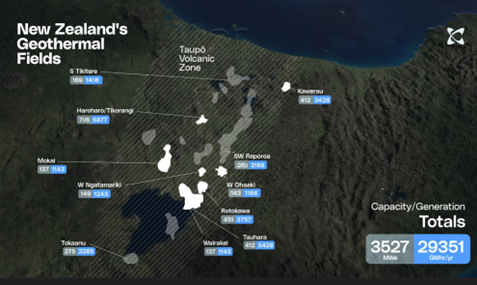Government exploring new renewable energy source
Published: 14 April, 2025
Up to $60 million will be ring-fenced from the Regional Infrastructure Fund to invest in exploring the potential of supercritical geothermal technology (SCGT).

The estimated capacity (MW) and generation (GWh/year) potential of developed geothermal fields in the Taupō Volcanic Zone (TVZ) if they were to tap into supercritical resources.
Regional Development Minister Shane Jones and Science, Innovation, and Technology Minister Judith Collins made the announcement on 14 November 2024.
Having a secure and resilient energy supply is a priority for New Zealand and is critical to rebuilding the economy and giving businesses the confidence to invest. It will reduce emissions and reliance on fuels such as gas and coal.
Hydroelectric generation currently provides 60% of our power needs. However, a lack of rain can quickly lead to energy shortages and power price hikes.
Geothermal energy is sourced from extremely hot rock heated by magma. At present, conventional geothermal wells are drilled to a maximum depth of about 3.5km. However, scientists believe that by drilling beyond this, possibly to 6km deep, more energy will be available. Developing and proving the drilling and engineering systems for extracting SCGT will be a big challenge and is globally ground-breaking.
The energy generated from SCGT could be up to three times greater than current geothermal energy from steam. In the long term this could be a game-changer for New Zealand and potentially internationally, with other countries also chasing solutions to energy challenges.
Initially only $5 million of the funding will be drawn down for work on the detailed design and cost to drill the first of three exploratory deep wells in the Taupō Volcanic Zone. The Government needs to fully understand whether the engineering technology to harness the energy can be developed before it considers releasing any further funds beyond the initial $5m. The Crown will also engage with stakeholders, particularly local iwi and hapū, on opportunities for involvement.

The initiative will be led by GNS Science and the Ministry of Business, Innovation & Employment (MBIE). The work will be informed by GNS Science research which was funded by the MBIE administered Endeavour Fund and years of other studies at the Taupō Volcanic Zone.
The Taupō Volcanic Zone is believed to be an excellent site to drill for SCGT as large sources of geothermal heat exist in Taupō at shallow depths and Earth’s crust is thinner there compared to almost every other place in the world.
The project is a long-term proposition, with a decision by the Government to start drilling the first well potentially being made by the end of 2025, with aspirational deployment of the technology between 2035-2040.
The Regional Infrastructure Fund (RIF) is a $1.2 billion investment fund that aims to build infrastructure for growth and resilience in our regions. The fund invests specifically in regional infrastructure, which includes building new infrastructure and improving existing structures to benefit regional businesses, organisations, and communities.
To be eligible for consideration for RIF funding, applicants must meet specified criteria, including aligning with their region’s priorities.

